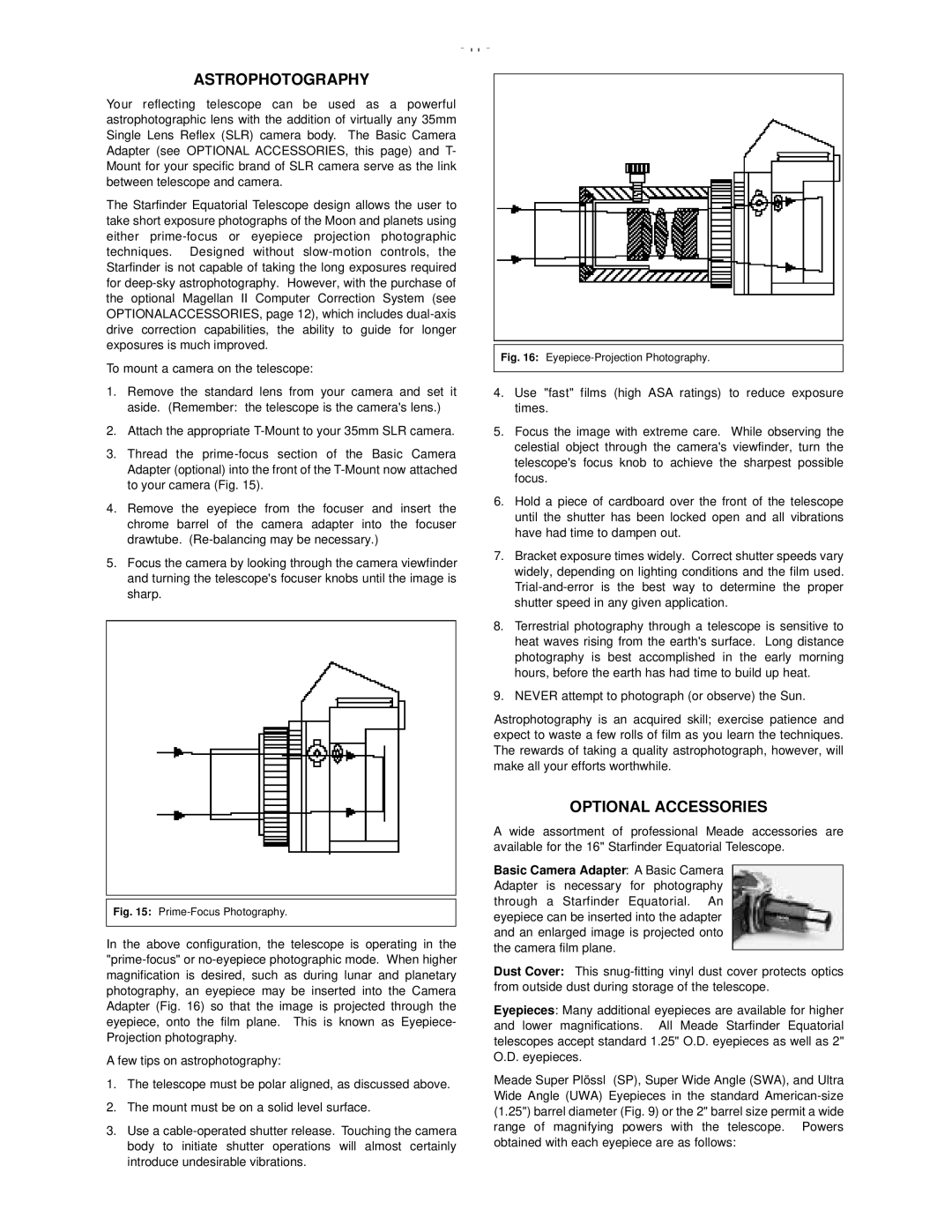
- 11 -
ASTROPHOTOGRAPHY
Your reflecting telescope can be used as a powerful astrophotographic lens with the addition of virtually any 35mm Single Lens Reflex (SLR) camera body. The Basic Camera Adapter (see OPTIONAL ACCESSORIES, this page) and T- Mount for your specific brand of SLR camera serve as the link between telescope and camera.
The Starfinder Equatorial Telescope design allows the user to take short exposure photographs of the Moon and planets using either
To mount a camera on the telescope:
1.Remove the standard lens from your camera and set it aside. (Remember: the telescope is the camera's lens.)
2.Attach the appropriate
3.Thread the
4.Remove the eyepiece from the focuser and insert the chrome barrel of the camera adapter into the focuser drawtube.
5.Focus the camera by looking through the camera viewfinder and turning the telescope's focuser knobs until the image is sharp.
Fig. 15: Prime-Focus Photography.
In the above configuration, the telescope is operating in the
A few tips on astrophotography:
1.The telescope must be polar aligned, as discussed above.
2.The mount must be on a solid level surface.
3.Use a
Fig. 16: Eyepiece-Projection Photography.
4.Use "fast" films (high ASA ratings) to reduce exposure times.
5.Focus the image with extreme care. While observing the celestial object through the camera's viewfinder, turn the telescope's focus knob to achieve the sharpest possible focus.
6.Hold a piece of cardboard over the front of the telescope until the shutter has been locked open and all vibrations have had time to dampen out.
7.Bracket exposure times widely. Correct shutter speeds vary widely, depending on lighting conditions and the film used.
8.Terrestrial photography through a telescope is sensitive to heat waves rising from the earth's surface. Long distance photography is best accomplished in the early morning hours, before the earth has had time to build up heat.
9.NEVER attempt to photograph (or observe) the Sun.
Astrophotography is an acquired skill; exercise patience and expect to waste a few rolls of film as you learn the techniques. The rewards of taking a quality astrophotograph, however, will make all your efforts worthwhile.
OPTIONAL ACCESSORIES
A wide assortment of professional Meade accessories are available for the 16" Starfinder Equatorial Telescope.
Basic Camera Adapter: A Basic Camera Adapter is necessary for photography through a Starfinder Equatorial. An eyepiece can be inserted into the adapter and an enlarged image is projected onto the camera film plane.
Dust Cover: This
Eyepieces: Many additional eyepieces are available for higher and lower magnifications. All Meade Starfinder Equatorial telescopes accept standard 1.25" O.D. eyepieces as well as 2" O.D. eyepieces.
Meade Super Plössl (SP), Super Wide Angle (SWA), and Ultra Wide Angle (UWA) Eyepieces in the standard
